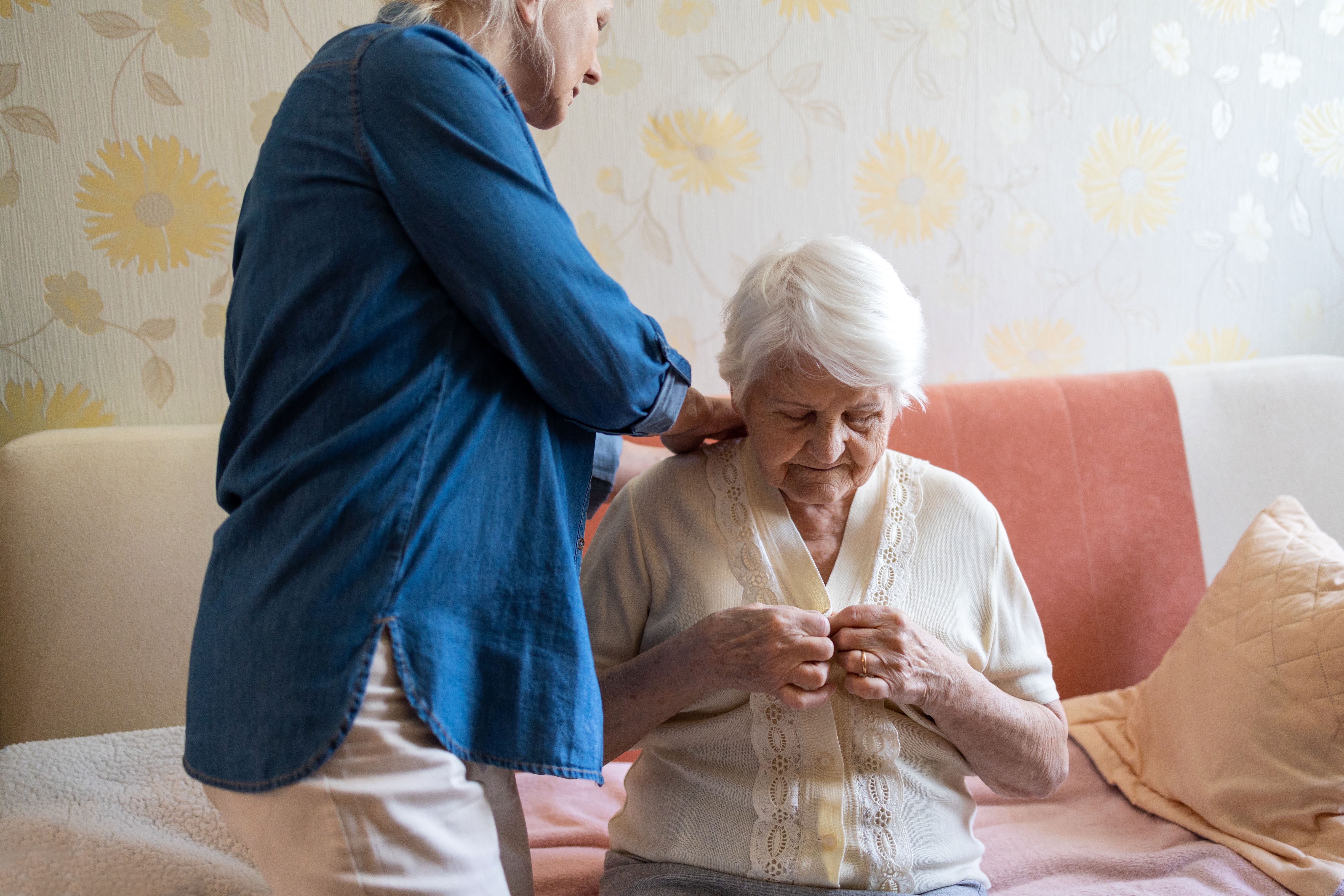Asset Publisher
Simplifying Personal Care Routines for People with Memory Loss
05/15/2023

A caregiver helping an older adult get dressed
As memory loss progresses, it can become increasingly difficult for older adults to manage many personal care activities. It takes longer for them to get dressed, groom themselves, take a bath and use the toilet. Busy caregivers sometimes decide that it's easier and faster to take over personal care tasks themselves. As a result, their loved one may gradually lose some of their independence and ability to manage their own care.
The easiest way to help your loved one retain independence in their personal care is to keep things simple and find ways for them stay involved in the process while still offering your help. Here are some tips to consider for various kinds of personal care routines:
Getting dressed
- People with memory loss often have trouble making decisions about what to wear. They may choose a warm winter sweater to wear in August or shorts in December. To avoid this, put clothes in your loved one’s drawers only for the current season, and provide them appropriate options to choose from for special occasions.
- Provide your loved one with comfortable clothes that fit well and are easy for them to put on and remove to make using the bathroom easy. Buttons and zippers are often hard to manipulate for people with memory loss, so choose clothes that fasten with Velcro or simple snaps, or have elastic waistbands.
Baths and showers
- Choose a day and time for bathing each week and ask your loved one if they prefer a bath or shower. Have soap, shampoo, clean towels, washcloths and a hand-held shower attachment ready for use and help your loved one as needed by reminding them of what parts of their body they need to clean and how to do so.
- Never leave your loved one with advanced memory loss alone in the bath or shower, but ask them if there is anything you can do to help them maintain privacy, like covering private areas with a washcloth or turning your attention to a book or magazine when they don’t need your help.
Oral care
- Have your loved one take the lead in brushing their teeth, but guide them using step-by-step instructions: “Hold your toothbrush.” “Put toothpaste on the brush.” “Brush your teeth.” Be patient. Wait until your loved one completes each step before moving on to the next one.
- If your loved one is having difficulty following a step, model the action using your own toothbrush. If necessary, you can guide your loved one’s arms, but make sure they’re comfortable with your touch before you do so.
Grooming
- Keep using your loved one’s favorite toiletries from the past, such as lotions, skin creams and/or makeup, so long as it is safe to keep using them.
- Make sure your loved one’s hairstyle is easy for them to take care of and maintain. If a new style is necessary, your loved one may be able to help pick out a new one using salon photos as reference.
- Use no-rinse shampoo in between washes if your loved one’s hair needs extra care.
Toileting
- Stick to a routine to make sure your loved one is using the toilet frequently and on a regular basis. Every two hours is a good starting point. Make sure your loved one drinks fluids at intervals that help support this schedule.
- Keep alert for signs that your loved one may need to use the toilet. Common signs are agitation, fidgeting, tugging on clothing and touching the genital area. Respond quickly when you see your loved one exhibiting these signs.
- Make sure your loved one’s pants and underwear are easy for them to lower on their own, and that they are reminded of the correct steps of using the bathroom if they need a little extra help.
- Have your loved one use a commode, bedpan or urinal at night so they aren’t stumbling around in the dark on their way to the bathroom. Using incontinence pads is also a way to protect bedding and clothing, and can also reassure your loved one that they do not have to try to rush to the bathroom.
Related Assets
Suggested Reads
6 Tips to Help a Loved One with Dressing
If a loved one we are helping is having trouble manipulating buttons or zippers, or is finding it difficult to maintain their balance when dressing, it may be time to for us to assist them with getting dressed. Here are some tips we can use to help us aid our ...
7 Tips to Help a Loved One Bathe
If our loved ones need assistance with bathing, it can be an uncomfortable experience for them to involve us, but it may be necessary for their health and well-being. We should be open with our loved ones about their bathing needs, and, if necessary, enlist th...
Helping an Older Loved One Maintain Good Oral Health
When caring for an older loved one with a chronic health condition or serious health concern, you most likely take them to regular appointments with doctors or specialists to assure that they are healthy and in the best possible condition. But with all these i...
